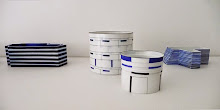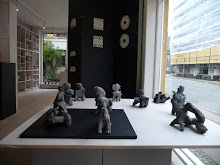


ALL TIMES - Jars
Gunilla Maria Åkesson, Samuel Johnson, Lotte Westphael
Exhibition 13 June – 10 August 2019 July: Wed-Fri 11-18.00
ALL TIMES - Jars, forever valid and valuable in their time.
Each jar has its story, reveals who the artist is, the place and time it originates.
The jar may be close to tradition, shows a modern technical making process, or be a textural masterpiece - and still reflects hands and the intimacy and character of the mind.



The traditional jar may also be a contemporary concept, an attitude, an artistic expression that give an image of artistic movement and direction of time.



Today, ceramic is HOT. Everyone relies and falls in love with the history, spaciousness and stability of this material. The jar is a container that stores, contains and keeps in its interior space. Books are written in honor of ceramics and currently in a Danish TV program are the making and evaluation of ceramics.
For the gallery's exhibition Form Language 2014, Ursula Munch-Petersen quoted a Chinese wisdom book Dàodéjīng (The Way of Virtue) by Lao Zi, around 6th century BC: "The meaning of the jar is what is not - the space inside."
The form of the jar is described by its shoulder, neck and foot. From beginning of time the human is included in the jar as a figurative form, ornament, abstraction.
The three invited artists each have their reasons, but all have beautiful simple, geometric expression and material surfaces as their focal point - and the value of craftsmanship.
 LOTTE WESTPHAEL's ceramic [MINDMAP] is based on a crafty sublime technique that unfolds in a carefully designed graphic universe. Embedded in the pieces is the story of 'time'.
LOTTE WESTPHAEL's ceramic [MINDMAP] is based on a crafty sublime technique that unfolds in a carefully designed graphic universe. Embedded in the pieces is the story of 'time'.The pieces in the exhibition, MindMap are self-referring and new interpreted compositions from her previous vessels, on harmony and disharmony in patterns and colour composition, but in more colours and shades than before.





She describes the works as a stroke in a development process. Each work is a study of characters of colour combinations and spans in shade.
- Do they all hold up? What adjustments in the next series?
She starts two-dimensional by constructing patterns in ultra-thin porcelain sheets, which ultimately bend and assemble into cylindrical jars, to be subsequently immortalized in the firing process. (Photos: Erik Balle)
 SAMUEL JOHNSON's unglazed, functional pottery are wood-fired in an anagama-type kiln for 3-4 days. The rustic surfaces of melted ash and encrusted embers are by-products of this firing process.
SAMUEL JOHNSON's unglazed, functional pottery are wood-fired in an anagama-type kiln for 3-4 days. The rustic surfaces of melted ash and encrusted embers are by-products of this firing process. Though appealing, these are incidental surfaces which are not meant to be decorative. The relationship of structures, issues of form or technique project a sense of order and subsequently disruption with elements that suggest disorder.





Samuel looks at old Silla ware, and most recently thinking about monochromatic painting. Inspired by artists Agnes Martin, Robert Ryman, the early black paintings of Frank Stella, Ad Reinhardt, Richard Serra.
His work holds the conventional notions of the pots – as bowl, as vase, as cup – to be easily recognized while other aspects of the work seem unfamiliar and austere. This tension creates a sense of mystery and invites engagement.
His ideas begin with research, inspired by much older forms. Not as reproduction of these things exactly, but an attraction to what feels significant.
He finds something powerful or contemporary in this historic reference and begins a process of reinterpretation. This approach also relates to a training as an apprentice within a generational ceramic tradition that requires a focused study of the tradition, until both technique and aesthetic sensibility is deeply instilled.
 GUNILLA MARIA ÅKESSON uses the classical cylinder shaped vessel as a white canvas to express her inmost experiences and feelings.
GUNILLA MARIA ÅKESSON uses the classical cylinder shaped vessel as a white canvas to express her inmost experiences and feelings. The pieces evolve with the change of emotions, and each series of work mainly get their individual expression by the use the glaze and slip.
The pieces hold a silent beauty of simplicity. The beauty that comes from within and evolves over time.





This intense notion of simplicity and strong presence are often what appeals to the viewer.
The inspiration comes from the continuous development of a creative process, the joy of being in the process trying out new ways to reach a desired expression.
The vessels are hand build by coiling and modelling the thin walls into large forms. The vessels are glazed with at least 2-5 different glazes and then fired several times to 1200C. (Photos: Peter Carlsson)
Grateful thanks to The Danish Art Foundation for project funding in 2019.
THE EXHIBITORS TEXTS AND BIOGRAFIES
 LOTTE WESTPHAEL - MINDMAP
LOTTE WESTPHAEL - MINDMAPMy ceramic [MINDMAP] is based on a personal immersion in a technique unfolded in a graphic universe.
I work with systematics, order and serial studies of implements. Thematically, I am inspired by woven Bauhaus fabrics.
I have developed the technique within several years. With strips of coloured porcelain, I work with vertical and horizontal lines. I work two-dimensional in porcelain, where I build patterns in 2 mm thin porcelain plates, which are ultimately assembled into cylindrical jars: Syncopes (= rhythmic displacement).'
I am interested in the cylinders dimensional potential, and works with the interaction between the jars inner and outer space.
The making process is slow and the waste rate is large.
 And I'm concerned with the small and large displacements that I can make in porcelain strips for this artistic construction. I am looking for variation in the detail - which may be of interest to the viewer.'
And I'm concerned with the small and large displacements that I can make in porcelain strips for this artistic construction. I am looking for variation in the detail - which may be of interest to the viewer.'METHOD - Some design approaches in the project:
- a colour matrix where I work with both the colour and its choice.
- Sections of geometric patterns, enlargement of these and repetitions.
- horizontal and vertical lines (some jars are collected by horizontal strips, others are joined by vertical)
- variation of porcelain strip width (narrow-wide-narrow, etc.)
Quote from the Application - Project support from the Danish Arts Foundation for production of works for the exhibition.
LOTTE WESTPHAEL (b. 1965) was educated at the Danish Design School Kolding 1988-92, Institute for Unika 1992-93. Studies in Japan. EXHIBITIONS 100 yeard in Danish Ceramics, Sofienholm 2019. [Albers] Translated into Transparency, Dina Vejling, Odense 2017. Ann Linnemann Gallery: Masterpieces 2018, World Cup 2017, Toy 2016. Charlottensborg Spring Exhibition 2016. INTERNATIONAL Lerverk, Göteborg. Danish Culture institute, St.Petersborg. Galerie de LÓ, Brussels 2016. Triennial of Silicate Arts, Hungary. Cluj Biennial Ceramics, Rumania 2017. Ceramic Art Andenne, Belgium. Farenheit 2018, American Museum of Ceramic Art, Plinth Gallery, Denver 2018. Biennale Vallauris, Design Miami-Basel 2019/Maria Wettergren Gallery. KAOLIN (solo), Stockholm 2019. AWARDS Danish Art Foundation, work stipend 2017, 18, project funding 2016, 18, 19. Arts&Crafts Award 2016. ”Villvinprisen”, Risør, Norway.
 SAMUEL JOHNSON
SAMUEL JOHNSON I have been exploring darkness in my work as a metaphor. In technical terms, the light-colored clay is transformed by reducing oxygen from the cooling phase of the firing and bathing the work in smoldering wood embers…. producing bands of color, iridescence, and dark surfaces that seem like shadows.
My aim is to produce raw unglazed functional pottery that is quietly confrontational, meditative, and still.
We have a capacity for reason and mathematical precision and yet are also half wild, full of biological and spiritual mysteries which drive our impulses despite existing, often, beneath consciousness. Poets refer to this as shadow – those aspects of our personality, our humanity, which are hidden from us.
Pottery’s capacity to carry a metaphor while remaining useful is an astonishing quality. Unlike paintings, or other forms of visual art where one interacts with the work primarily through sight, pottery can enter our lives though the body and our lived experience – though its physical balance, heft, and touch we experience its secrets. The best of this work enters slowly and over time with use.
SAMUEL JOHNSON (b.1973) is Professor of Art at the College of Saint Benedict and Saint John’s University and serves on the Advisory Board of the international ceramic organization, Artaxis. He has participated in several group and solo exhibitions including Jane Hartsook Gallery, NYC (2018, 14) and Beauty of Zen, Ann Linnemann Gallery 2016. COLLECTIONS the North Dakota Museum of Art, the Rourke Art Museum, the Minnesota History Museum. PUBLICATIONS New York Times (May 9, 2019) and several books: 40 Years On; Pottery of the St. John’s Pottery Studio (2019), Ceramics Now (2018), Mastering the Potter’s Wheel (2016), Ceramics Now (2014), and Stoked: Five Artists of Fire and Clay (2010). Samuel grew up on the western prairie of the Red River Valley, outside of Breckenridge, Minnesota (USA) in 1973. Before earning his MA and MFA from the University of Iowa (2005), he apprenticed with Richard Bresnahan (1996-1999), studied ceramic design at the Danish Design School in Copenhagen, Denmark (2000), and worked in Japan as a studio guest of Koie Ryoji (2001). He lives in rural St. Joseph, Minnesota, with his wife, Anne, and their four children, Harriet, Jesse, Ingrid, and Francine.
 GUNILLA MARIA ÅKESSON
GUNILLA MARIA ÅKESSONI am a ceramic artist who primarily works with unique objects in clay. My inspiration comes forth during the creative process, where impulses and ideas develop gradually when I work with the object.
My objects are hand built. To build by hand takes a long time and it can often be monotonous, but at the same time I can experience it as a daily meditation. During the time it takes for my work to develop I start to see the potential in it.
The potential often appears as a feeling, the intuitive feeling when I know whether I am on the track or not. Here my curiosity and inspiration awakens because I find something in the form that I want to make clear.
It has a story to tell.
My way of using clay means that I often work with series of the same basic shape, but it always takes various forms. The result will be unique objects for exhibitions, public spaces and private homes.
GUNILLA MARIA ÅKESSON (b. 1963, Älghult, Sweden) studied at the National College of Art and Design, Bergen, Norway 1987-92. EXHIBITIONS Solo Blås & Knåda, Stockholm and Galleri PING PONG, Malmö. Modern Masters, Munich, 2019. Finalist, Loewe Craft Prize Award. Solo Puls Ceramics, Brussels. Contemporary Ceramic Center, London 2018. Collect, Saatchi Gallery, London 2013-18. COLLECTIONS Region Västra Götaland, Public Art Agency Sweden (Statens Konstråd), Arts Council Norway, Royal Department of Foreign Affairs (N), Innkjøpstfondet for Norsk Kunsthåndverk and several private collections in Europe. Member of Konsthantverkarna, Stockholm.








































































































